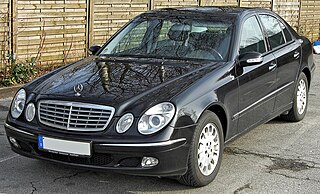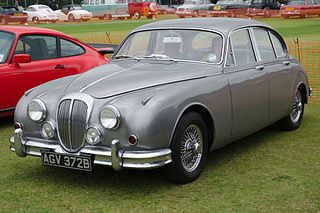
The Mercedes-Benz S-Class, formerly known as Sonderklasse, is a series of full-sized luxury sedans, limousines and armored sedans produced by the German automaker Mercedes-Benz. The S-Class is the designation for top-of-the-line Mercedes-Benz models and was officially introduced in 1972 with the W116, and has remained in use ever since. The S-Class is the flagship vehicle for Mercedes-Benz and is positioned above the other models.

The Mercedes-Benz 300 SEL 6.3 is a full-sized luxury performance car built by Mercedes-Benz from 1968 to 1972. It featured the company's powerful 6.3-litre M100 V8 from the flagship 600 (W100) limousine installed in the normally six-cylinder powered Mercedes-Benz 300 SEL (W109). The result was a nearly 2-ton sports sedan with muscle car performance. At the time of its release it was one of the world's fastest four-door cars.

The Chrysler 300 is a full-size car manufactured and marketed by Stellantis North America and its predecessor companies as a four-door sedan and station wagon in its first generation and solely as a four-door sedan in its second generation.

The Mercedes-Benz GLE, formerly Mercedes-Benz M-Class, is a mid-size luxury SUV produced by the German manufacturer Mercedes-Benz since 1997. In terms of size, it is slotted in between the smaller GLC and the larger GLS, the latter with which it shares platforms.
Mercedes-AMG GmbH, commonly known as AMG, is the high-performance subsidiary of Mercedes-Benz AG. AMG independently hires engineers and contracts with manufacturers to customize Mercedes-Benz AMG vehicles. The company has its headquarters in Affalterbach, Baden-Württemberg, Germany.

The Lancia Thema is an executive car produced by the Italian automaker Lancia between 1984 and 1994, and one of four cars to share the Type Four platform alongside the Alfa Romeo 164, Fiat Croma and Saab 9000. The Thema was first shown in Turin Motor Show in 1984.

Brabus GmbH is a German high-performance automotive aftermarket tuning company founded in 1977 in Bottrop. Brabus specialises mainly in Mercedes-Benz, Maybach and Smart vehicles. They have also modified other vehicles too, including Porsche.

The Volga is an executive car that originated in the Soviet Union to replace the GAZ Pobeda in 1956. Their role in serving the Soviet nomenklatura made them a contemporary cultural icon. Several generations of the car have been produced.

The Mercedes-Benz W211 is the third generation Mercedes-Benz E-Class made from 2001 to 2009 in sedan/saloon and station wagon/estate configurations – replacing the W210 E-Class models and superseded by the Mercedes-Benz W212 in 2009.

The Mercedes-Benz W126 is a series of passenger cars made by Daimler-Benz AG. It was marketed as the second generation of the Mercedes-Benz S-Class, and manufactured in sedan/saloon (1979–1991) as well as coupé (1981–1990) models, succeeding the company's W116 range. Mercedes-Benz introduced the 2-door C126 coupé model, marketed as the SEC, in September 1981. This generation was the first S-Class to have separate chassis codes for standard and long wheelbases and for coupé (C126).

The Mercedes-Benz W140 is a series of flagship vehicles manufactured by Mercedes-Benz from 1991 to 1998 in sedan/saloon and coupe body styles and two wheelbase lengths. Mercedes-Benz unveiled the W140 S-Class at Geneva International Motor Show in March 1991, with the sales starting in April 1991 and North American launch was on 6 August 1991.
Renntech Inc. is an American high-performance automotive aftermarket tuning company founded in 1989, with their headquarters located in Stuart, Florida. RENNtech specializes in engineering, designing and manufacturing parts for Mercedes-Benz, AMG, Maybach and Mercedes-Benz Sprinter vehicles as well as other European luxury and performance vehicles. RENNtech also operates a full motorsport division named RENNtech Motorsports fielding a Mercedes-AMG GT4 racecar in SRO's North American GT -series. RENNtech Classics was founded to offer a wider range of services for owners of early RENNtech, Pre-Merger AMG, and collectible Mercedes-Benz vehicles.

The sixth and seventh-generation Dodge Charger are full-size four-door sedan, first introduced at the 2005 North American International Auto Show and built by American automobile manufacturer Stellantis North America, a subsidiary of Stellantis. It is available in rear-wheel drive or all-wheel drive drivetrains. The Charger was developed to continue the Dodge Charger line with its muscle car heritage, and replaced the Dodge Intrepid as Dodge's full-size sedan. The seventh generation Charger debuted for the 2011 model year.

The Daimler 2.5 V8/V8-250 is a four-door saloon which was produced by The Daimler Company Limited in the United Kingdom from 1962 to 1969. It was the first Daimler car to be based on a Jaguar platform, the first with a unit body, and the last to feature a Daimler engine after the company was bought from the Birmingham Small Arms Company by Jaguar Cars in 1960. The engine is the hemispherical head V8 designed by Edward Turner and first used in the Daimler SP250 sports car.

Executive car is a British term for a large car which is equivalent to the European E-segment and American full-size classifications. Executive cars are larger than compact executive cars, and smaller than luxury saloons / full-size luxury sedans.

The Daimler SP250 is a sports car built by the Daimler Company, a British manufacturer in Coventry, from 1959 to 1964. It was the last car to be launched by Daimler before its parent company, the Birmingham Small Arms Company (BSA), sold it to Jaguar Cars in 1960.

A V8 engine is an eight-cylinder piston engine in which two banks of four cylinders share a common crankshaft and are arranged in a V configuration.

The Mercedes-Benz C-Class (W203) is the internal designation for a range of compact executive cars manufactured and marketed by DaimlerChrysler from 1999 to 2010, as the second generation of the C-Class — in sedan/saloon, three-door hatchback coupé and station wagon/estate body styles.
PT Mercedes-Benz Distribution Indonesia is the official agent of Mercedes-Benz cars in Indonesia which has become the number one selling premium brand in Indonesia.

















